| At a Glance | |
|---|---|
| Product | QNAP TS-251 & TS-451 Turbo NASes [Website] |
| Summary | Intel dual-core Celeron-powered NASes with dual Gigabit LAN, USB 3.0 and HDMI port. |
| Pros | • Supports up to 8 GB of RAM • Wide range of downloadable apps • Quiet • Updated user interface |
| Cons | • TS-451 is expensive compared to similarly performing TS-469L |
Introduction
QNAP recently upgraded its Home and SOHO NAS family with the TS-x51 series with two, four, six and eight bay models. All share a common hardware platform with two variations. The white TS-251 (2 bay) and TS-451 (4 bay) use the same main board with two each USB 2.0 and USB 3.0 ports.
The black TS-651 (6 bay) and TS-851 (8 bay) share a different main board that supports three USB 3.0 ports. The larger models also use a different SATA device to support the greater number of drive bays. So while the family includes four models, this review will focus on the two and four-bay models.
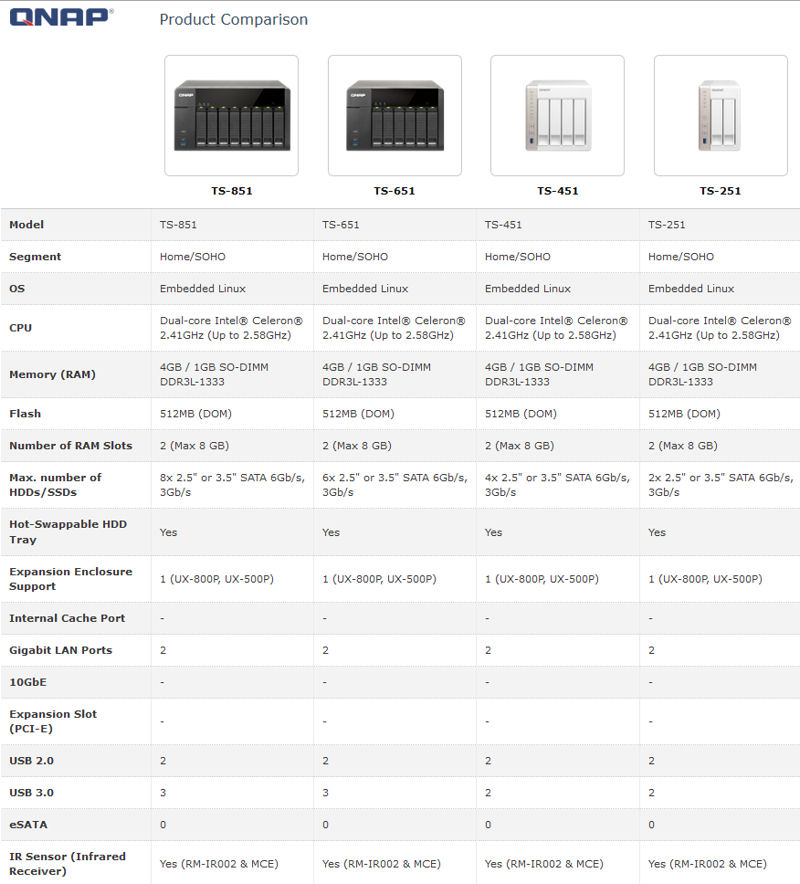
QNAP TS-x51 product comparison
Each product in the TS-X51 family is available with 1 GB or 4 GB (2 X 2 GB) of SoDIMM RAM that can be expanded to a total of 8 GB. The 4 GB model costs $60 more than the corresponding 1 GB model on Amazon. The additional power of the Celeron processor and additional memory will come in handy to support Virtualization Station and new QvPC features coming in QTS 4.1.2.
Below is a screenshot showing the callouts for the front and rear panels for the four models. Each front panel has LED indicators for each disk, power button, IR receiver, One Touch Copy button and a single USB 3.0 port. Although the TS-651 and 851 look like they have a status panel, the callouts show that all that’s behind the dark plastic panel running along upper front panel is an IR receiver.
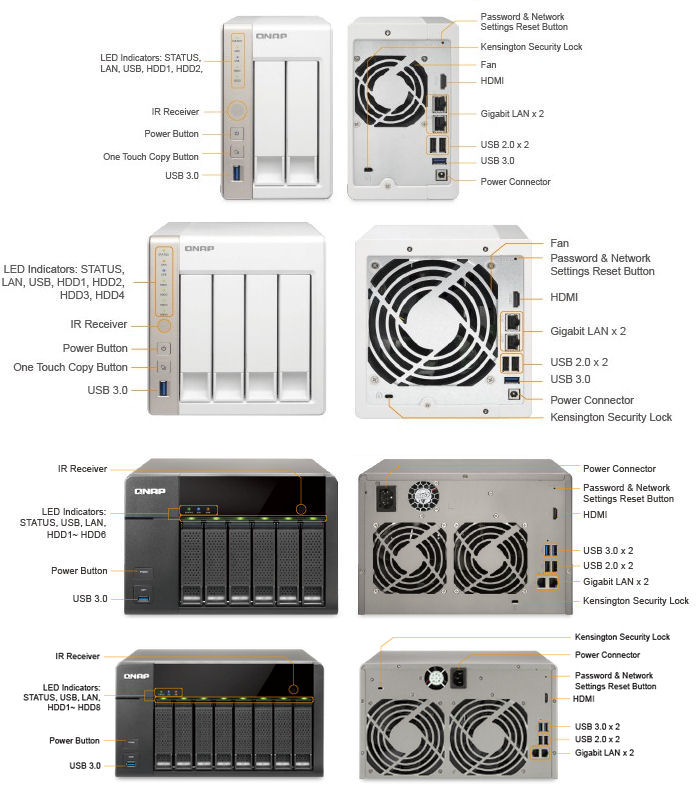
Front and rear panel callouts
The TS-251 and 421 rear panels have a power connector for the external brick, two Gigabit LAN ports, reset button, two USB 2.0 ports, security slot, HDMI port and fan. The TS-651 and 851 have a built-in power supply so you’ll find an AC receptacle. The TS-651 and 851 also have dual fans as well as two USB 3.0 ports (in addition to the one on the front panel).
Inside
We disassembled the TS-451 to take the photos and identify components. Disassembly is easy and QNAP even provides instructions. The easy backplane removal will be particularly welcome if you opt for a RAM upgrade.
All -x51 series models use a 2.41 GHz Intel Celeron J1800 (Bay Trail D) dual-core processor, sitting under the heatsink in the photo below. As noted earlier, the TS-651 and 851 use a different board with dual-stacked USB 3.0 and Gigabit Ethernet ports.
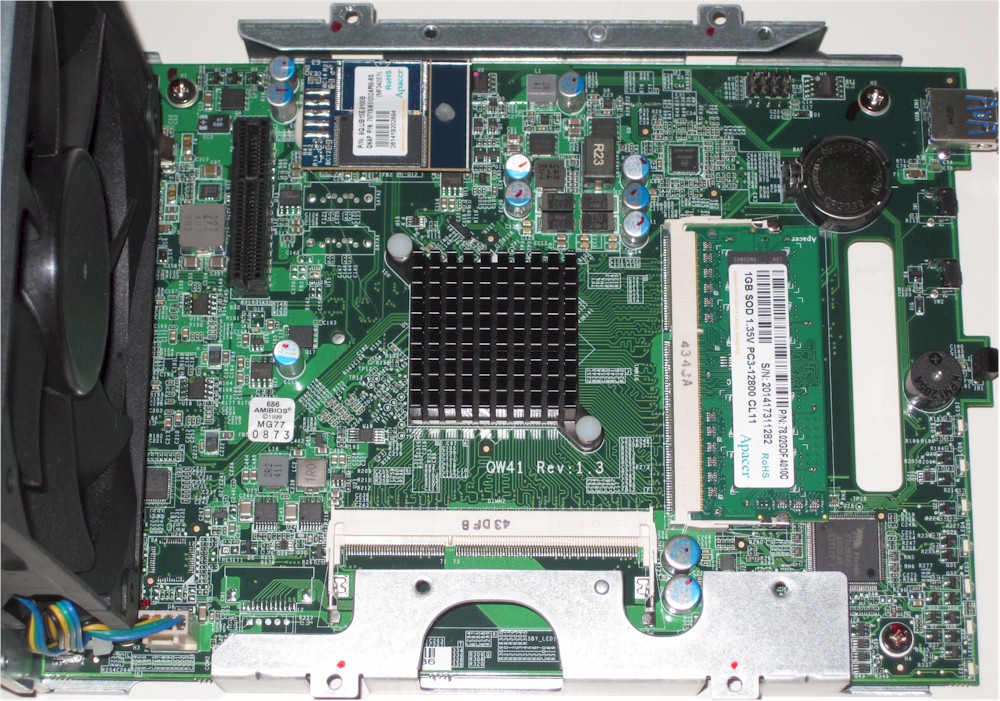
QNAP TS-451 main PCB
SATA for the 251 and 451 drive bays is provided by Asmedia ASM1061 dual-port PCIe to SATA host controllers mounted on the drive bay backplane. According to Legion Hardware’s review, the 651 an 851 use Marvell 88SE9215 quad-port 6 Gb/s PCIe – SATA host controllers mounted on their larger drive backplanes.
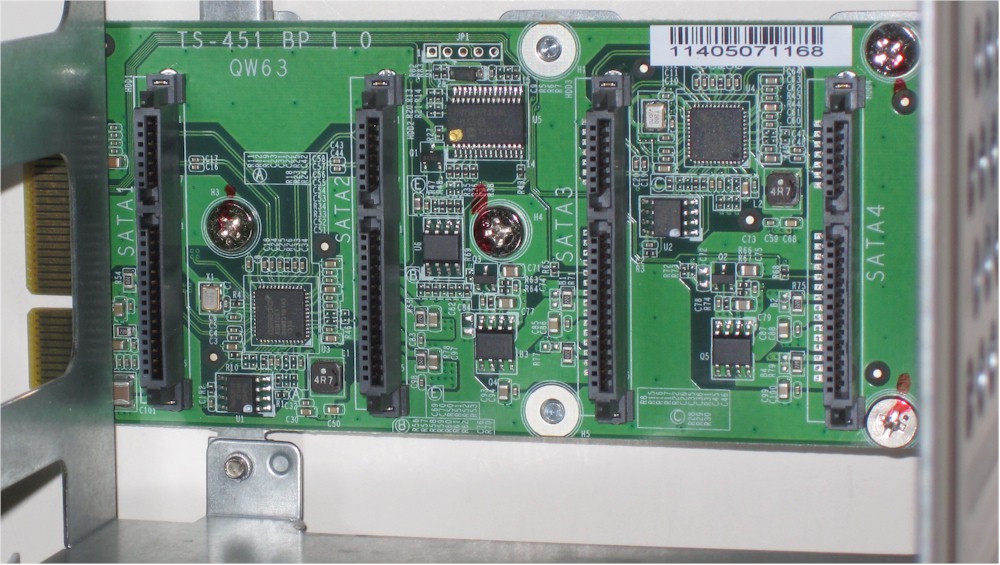
QNAP TS-451 backplane PCB
Table 1 summarizes key components.
| TS-251 / TS-451 | TS-651 / TS-851 | |
|---|---|---|
| CPU | Intel Celeron J1800 dual-core processor @ 2.41 GHz (Bay Trail D) | Intel Celeron J1800 dual-core processor @ 2.41 GHz (Bay Trail D) |
| RAM | 1 GB DDR3 SoDIMM (expandable to 8 GB) | 1 GB DDR3 SoDIMM (expandable to 8 GB) |
| Flash | 512 MB DOM | 512 MB DOM |
| Ethernet | Intel WGI210TA (x2) | Intel WGI210TA (x2) |
| USB 3.0 | Asmedia 1074 USB 3.0 quad port hub | Asmedia 1074 USB 3.0 quad port hub |
| SATA | Asmedia ASM1061 (x2 for TS-451) | Marvell 88SE9215 quad-port 6 Gb/s PCIe – SATA host controllers (x2) |
| HDMI | Asmedia ASM1442 level shifter | Asmedia ASM1442 level shifter |
Table 1: Key component summary and comparison
QNAP equipped the TS-451 review sample with four Seagate NAS HDD 3 TB (ST3000VN000) drives for testing. Power consumption measured 31 W with the 4 drives spun up and 13 W with them spun down. With only two drives inserted for the TS-251 tests, power consumption dropped to 19W with the drives spun up. Fan and drive noise could be classified as low, i.e. barely audible in a quiet home office.
Features
Section written by Tim Higgins
Craig recently reviewed QTS 4.1 QNAP’s most recent NAS OS. QNAP also has a live demo that allows you to explore the features. Currently, the demo is based on QTS 4.1.0.![]()
Since that review, QNAP has released 4.1.1, which appears to introduce some significant changes. The "HD" in HD Station now means "HybridDesk" vs. "High Definition", perhaps in preparation for the upcoming introduction of QvPC features in QTS 4.1.2 noted earlier. (I somehow missed the TS-x53 series announcement a few weeks ago that included the QvPC introduction.)
HybridDesk Station must first itself be installed and also provides installers for the CodexPack required to enable hardware transcoding in HS-251, TS-X51 and TS-X53 models. You’ll also find installers for Chrome, XBMC, YouTube, QTS, Spotify and Surveillance Station (Local Display).
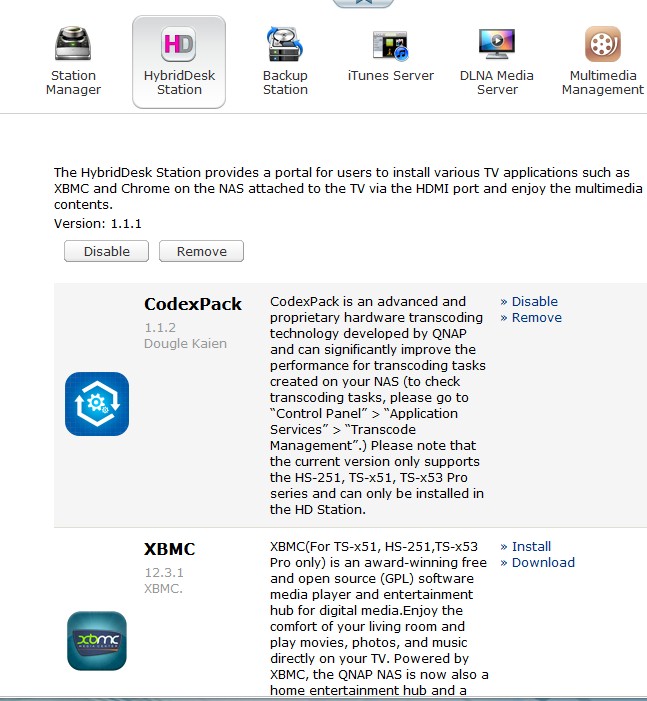
HybridDesk Station
I’m sure QNAP has its reasons, but having this mini App Center is confusing. But so is having multiple versions of NAS and mobile device apps that sorta do the same thing.
On-The-Fly Transcoding
Section written by Tim Higgins
A specific example is what happened when I tried to test real-time transcoding. This feature appears to have been added in QTS 4.1.1, which is why Craig didn’t catch it in his QTS 4.1 review. The composite screenshot below compares the Tranacode Management screens for QTS 4.1.0 (top) and QTS 4.1.1 (bottom).
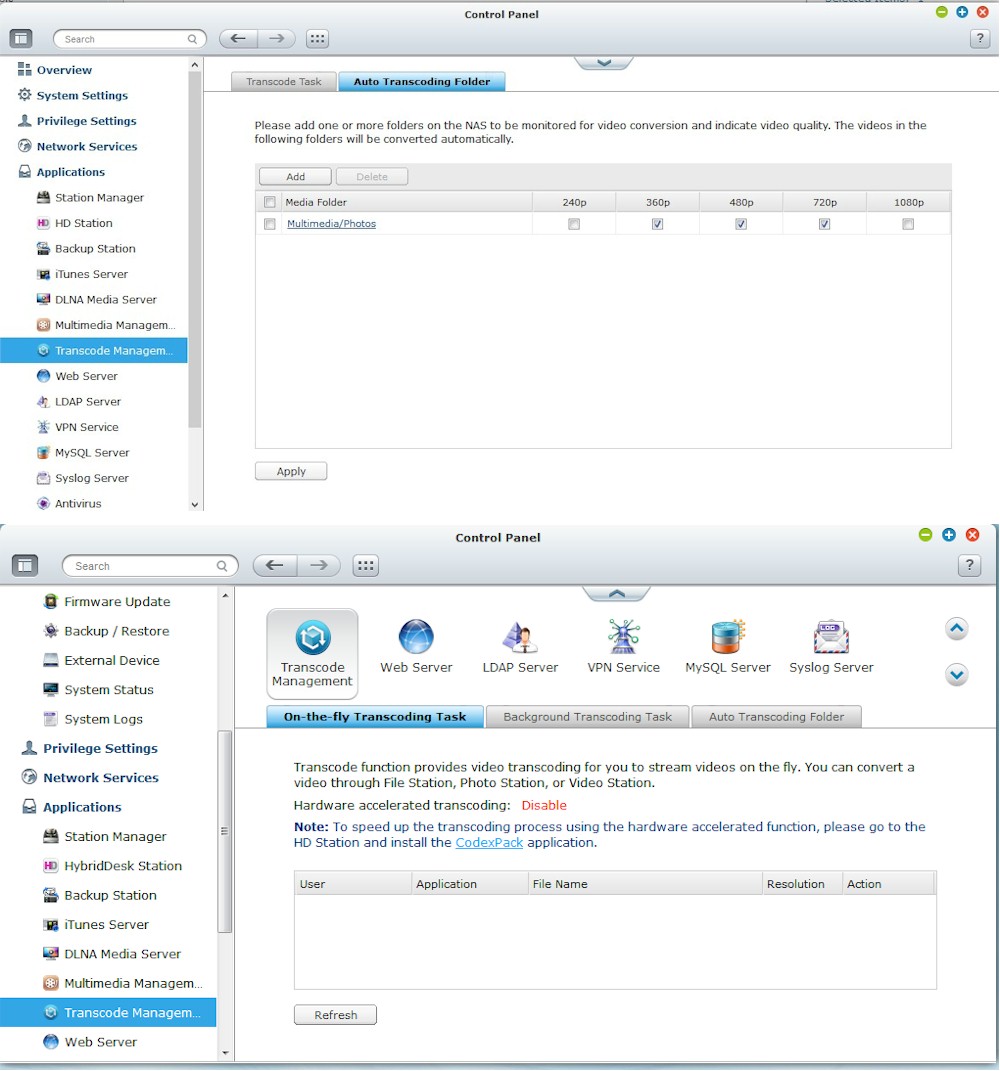
QTS 4.1.0 and 4.1.1 Transcode Management screens
I had a false start trying to use the now obsolete QMobile app (replaced with QFile) on a Nexus 7, which sent me chasing my tail working with the now equally obsolete Multimedia Station (replaced with separate Photo, Music and Video Stations NAS apps).
I then bumped into a problem using QFile, which froze after a pop-up telling me "to enrich your user experience, it is recommended [emphasis mine] to install 3rd party Apps, such as Mxplayer, Vplayer, etc.". Turns out the freeze was a bug, which is now fixed with new versions of QFile (1.0.1 for Tablet and 1.6.1 for Phone, I’m told).
I was also told, however, that the "recommendation" in the message is actually a requirement, "in order to play those formats which are not supported by the device natively". Uh, but isn’t that the purpose of on-the-fly transcoding, to make any file playable by any device? (QNAP pointed out that Synology has the same requirement for its Android DS video app.)
In the end, I was not successful in getting QFile (or QFile HD on a Samsung Galaxy Tab S–nice tablet by the way) to trigger an automatic transcoding. The only time I was able to see an entry pop up in the On-the-fly Transcoding tab was when I played a video that somehow managed to get into Video Station, which I had tried as a last resort.
I also tried to test automatic transcoding by using a Roku 3. I was surprised to find that the Roku Media Player can now access files on DLNA servers instead of only those on an attached USB drive. But, alas, the Player will show only files in formats that the Roku can natively play. So I couldn’t even try asking the TS-451 to auto-transcode because the Roku wouldn’t show me any files that needed to be transcoded!
Synology handled this by creating a DS video Roku "channel", which Craig used to successfully test auto-transcoded video in his DSM 5.0 review using his Roku 3. QNAP says it is looking into creating its own channel for the Roku.
So, for now at least, Synology has a big edge over QNAP when it comes to ease of use for on-the-fly transcoding.
Performance Summaries
Version 4.1.1 Build 20140820 firmware was loaded on a TS-451 for our standard NAS test process. As we have done in similar reviews, we ran tests posted for the TS-251 using the TS-451 loaded with only two drives configured in RAID 0 and 1 volumes. The TS-451 tests used four drives configured in RAID 0, 5 and 10 volumes.
Windows File Copy Write and Read performance for the TS-451 was very consistent across RAID 0, RAID 5 and RAID 10 volumes , with reads (107.6, 106.7 and 107.4 MB/s) slightly lower than writes (110.1, 109.4, and 110.0 MB/s).
NASPT File Copy to NAS (write) was also consistently higher than the corresponding Windows File Copy Write Performance for each RAID type. NASPT File Copy from NAS was consistently lower than the corresponding Windows File Copy Read Performance for each RAID type. All things considered, however, this is clearly a NAS capable of 100 MB/s+ throughput moving large files around.
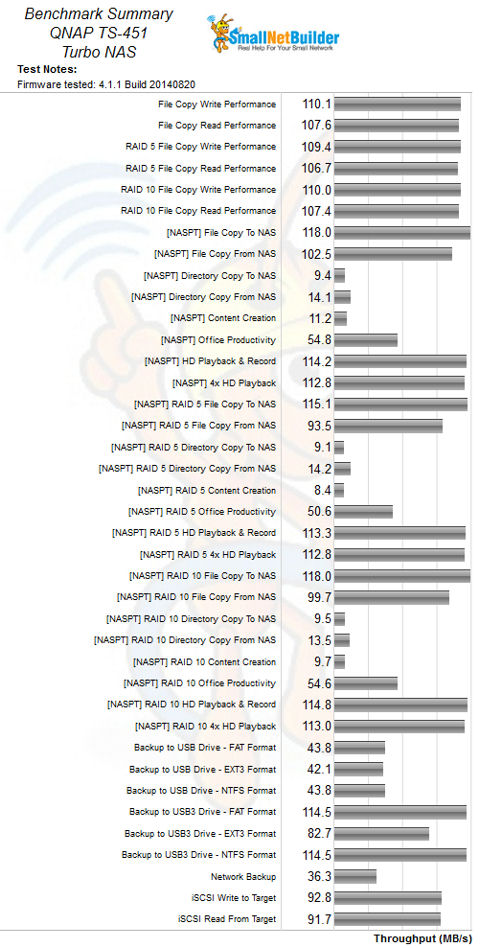
QNAP TS-451 Benchmark Summary
With two drives representing the TS-251‘s performance, File Copy Write performance was almost identical to the results achieved using four drives on the TS-451. (110.1 vs. 110.5 MB/s). However File Copy Read performance with two drives was about 12% less than with four drives (94.3 vs. 107.6 MB/s). RAID 1 File Copy Read and Write performance was in line with corresponding RAID 5 and RAID 10 results turned in with four drives. For NASPT File Copy tests, Copy to NAS was consistently higher than Copy from NAS for both RAID 0 and RAID 1.
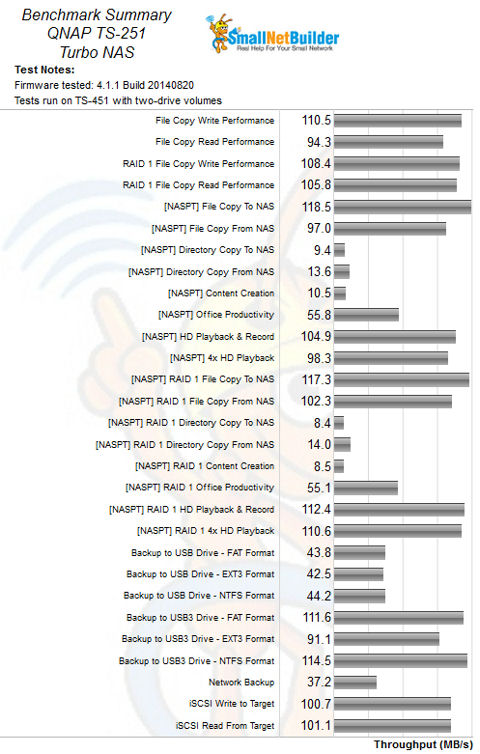
QNAP TS-251 Benchmark Summary
Performance – Ranking
For our ranker comparison, we decided to compare the TS-x5’s with QNAP D2700 Atom-based NASes. For the two bay comparison, we compared the TS-251 to the TS-269 Pro. For the four bay comparison, we compared the TS-451 to the TS-469L. The chart below summarizes the CPU, RAM and flash for each product.
| TS-251 | TS-469L | TS-269 Pro | |
|---|---|---|---|
| CPU | Intel Celeron J1800 dual core processor @ 2.41 GHz (Bay Trail D) | Intel D2700 @ 2.13 GHz | Intel D2700 @ 2.13 GHz |
| RAM | 1 GB | 1 GB | 1 GB |
| Flash | 512 MB | 512 MB | 512 MB |
Table 2: Key component summary and comparison
Using the NAS Ranker, I filtered for two drives and did not add an additional processor class filter. Interestingly, the TS-269 Pro and the TS-251 were tied with a #2 ranking out of 29 2 bay NASes.
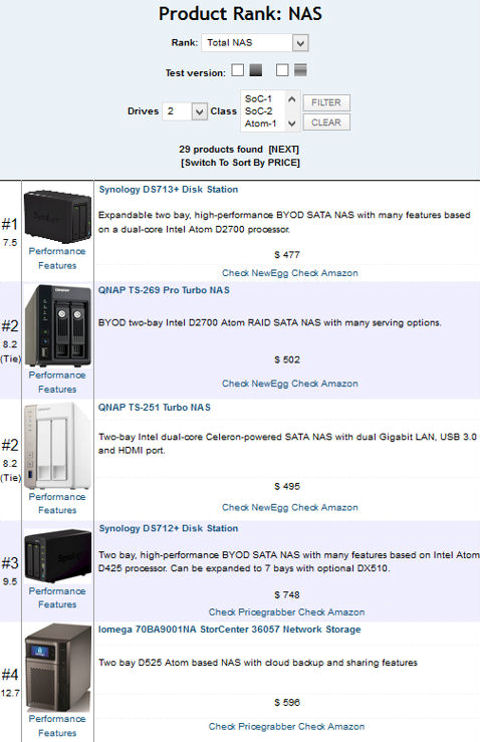
NAS ranker for two bay NASes – Total NAS
The composite chart below shows individual results for each product. The TS-269 Pro had category wins for Write Benchmarks, Read Benchmarks and Mixed Read Write benchmarks. The TS-251 prevailed in the other three categories. The write benchmarks appeared to be dragged down by relatively low NASPT Directory Copy to NAS performance. Similarly, for Read Benchmarks, the NASPT Directory Copy From NAS dragged down otherwise good performance.
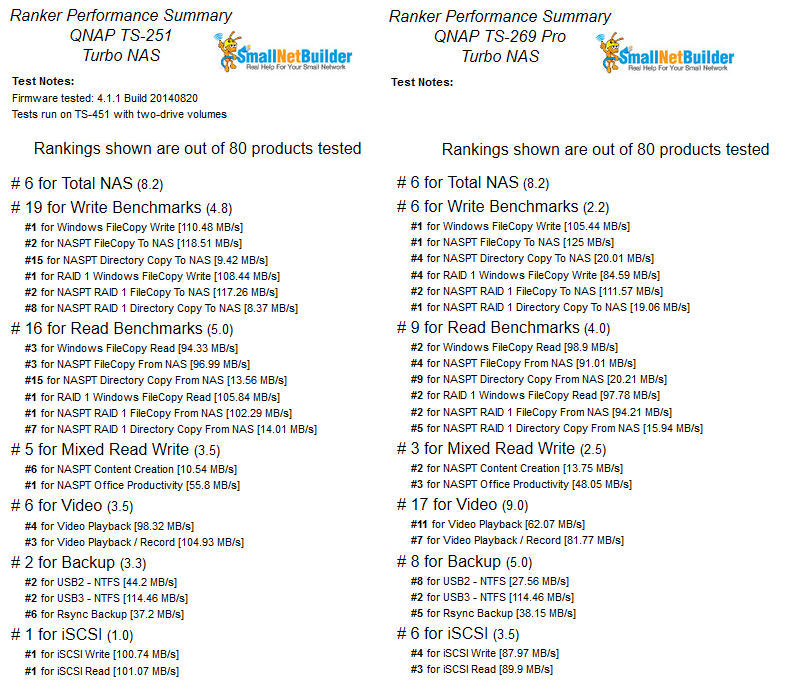
Ranker detail for QNAP’s TS-251 and TS-269 Pro
Filtering for four drives showed some surprisingly interesting rankings. The TS-451 was in a three-way tie for third place (out of 24 four-bay NASes) with the TS-469L and ASUSTOR AS-604T. All three products ranked slightly behind the Synology DS412+ Disk Station that is also Atom D2700-powered.
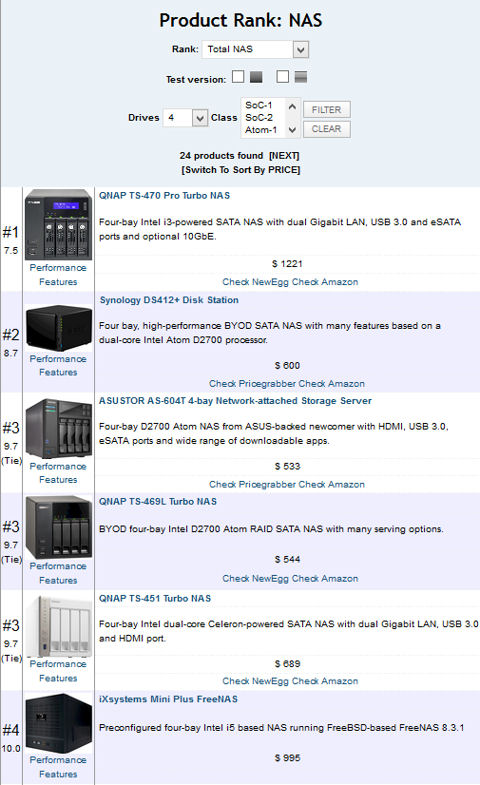
NAS ranker for two bay NASes – Total NAS
Comparing Performance Summaries for the two QNAPs shows the D2700-based TS-469L outperformed the TS-451 in both write and read benchmarks. NASPT Directory Copy to NAS and NASPT RAID 10 Directory Copy to NAS pulled down the the overall Write Benchmarks. For Read benchmarks, various NASPT results dragged down the category score. As with the TS-251, the TS-451 scored well for Video, Backup and iSCSI.
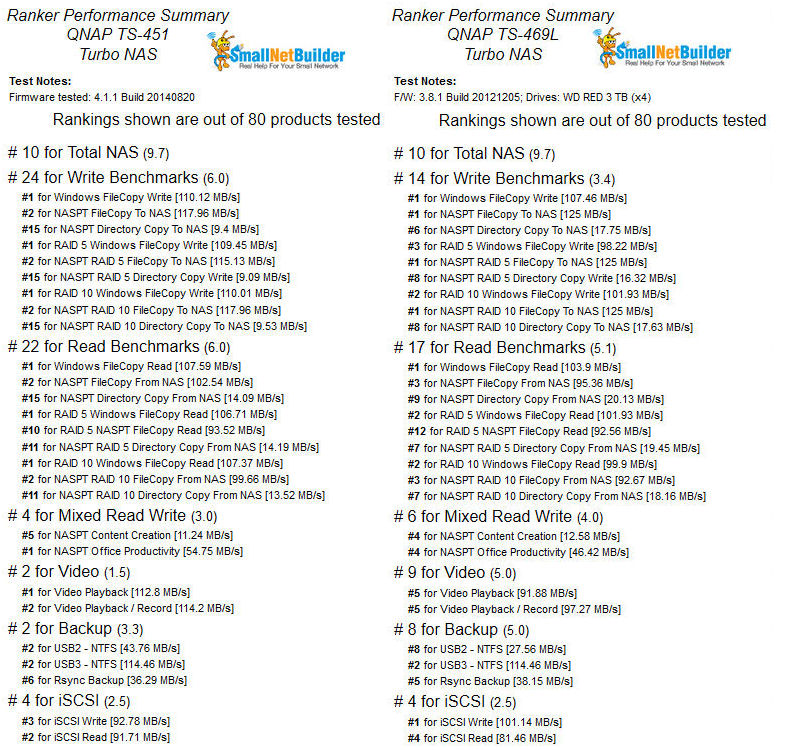
Ranker detail for QNAP’s TS-451 and TS-469L
Closing Thoughts
There’s no question that the TS-251 and TS-451 are high-performance NASes capable of large sequential file reads and writes of over 100 MB/s. But it’s not clear that the switch to Intel’s Bay Trail processor provides a price / performance point that you can’t already get with existing QNAP models.
For a two bay NAS, it’s a toss-up between the TS-251 and the almost two year old TS-269 Pro. Both are equally ranked for Total NAS performance and are similarly priced. On Amazon, the TS-251 is currently listed for $499.00 while the TS-269 Pro sells for $501.99.
If you’re looking at four-bays, the TS-451 tied the older TS-469L for Total NAS ranking. But the TS-451’s price could very well tip you toward the older product. The TS-451 is currently selling on Amazon for almost $700 (!), while the TS-469L is considerably less at around $550 (the ASUSTOR AS-604T is $542). For very similar performance, the $149 premium on the TS-451 seems like a steep price to pay for the ability to upgrade RAM to 8 GB.
In the end, the value-add in the TS-X51’s may be more in their expandable memory and hardware transcoding (when QNAP sorts out the ease-of-use issues) looking toward Virtualization and PC-replacement applications than in mundane file reading and writing. But if Virtualization and PC replacement are what you’re thinking of, you might want to spend even more for the also-newly-released and even spendier TS-X53 Pro’s. We’ll soon be looking at those, too.
